Click to check for an upcoming screening near you
Raising sheep and growing grain on a small farm in Henry County, Wendell Berry has lived deeply connected to the land in his native Kentucky. But in between planting and picking, Berry has devoted himself to words. His more than forty novels, essays, and poetry collections have made the 82-year-old author one of the country’s most prominent voices on the value of small-scale farming and rural life, earning him honors including the National Humanities Medal and a spot in the Kentucky Writers Hall of Fame. Now, the first film devoted to Berry’s vision, Look & See, shares an insider’s perspective of his philosophy and community. “I wanted to document Wendell’s world and what he cares most about—farmers, who are his neighbors and friends,” says the Austin, Texas–based director Laura Dunn, who worked on the project for ten years.
Through interviews with Henry County residents, historic photographs from Berry’s life, and beautiful shots of the rural Kentucky landscape, Look & See explores both the upheavals wrought by industrial agriculture and the humble, persistent ethos that has guided Berry’s path. Although the camera-shy Berry prefers to tell stories through writing, his wife and daughter appear on screen, and he participated in the documentary by reading his poems and shaping the way the cinematography chronicled all four seasons of farm life in the Bluegrass State. Executive produced by Robert Redford and Terrence Malick, Look & See premiered on June 30 in New York and will screen this summer at venues across the country, including in Virginia, Tennessee, Georgia, Texas, North Carolina, and Kentucky. And while the film charts the struggles of modern farmers, it also sounds a note of optimism, provided by the voices of those inspired by Berry’s writing and presence. “You can’t oversimplify his worldview because it’s layered and complex,” Dunn says. “But at the heart of it is hope.”








